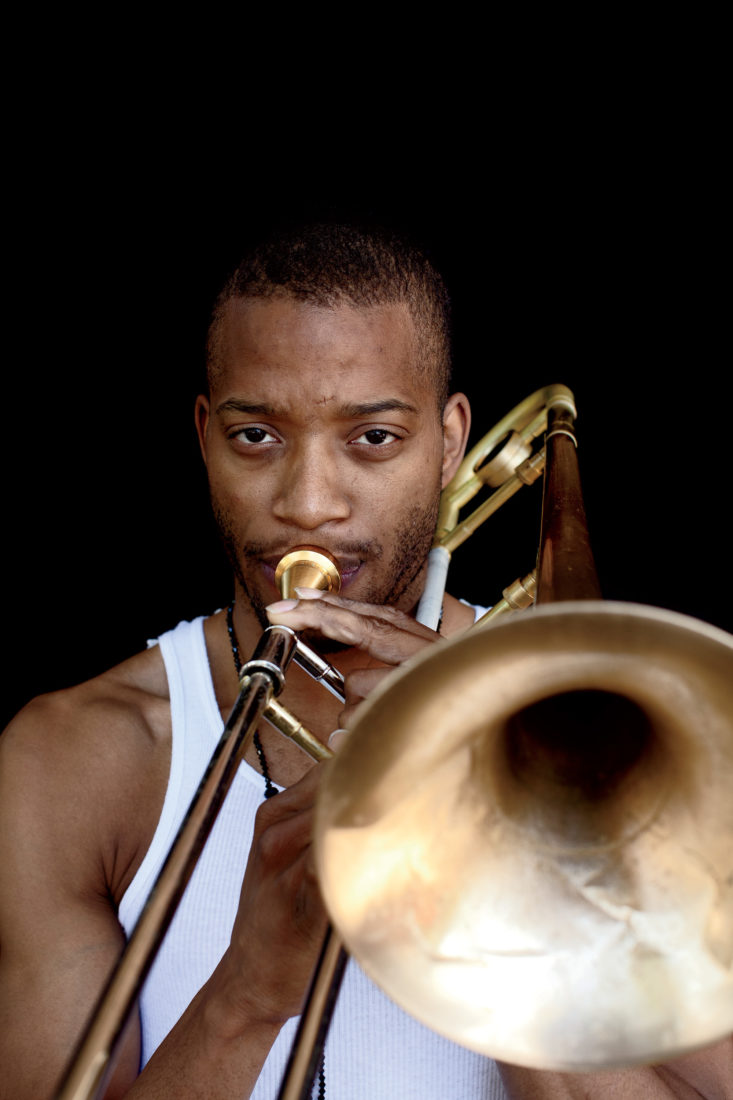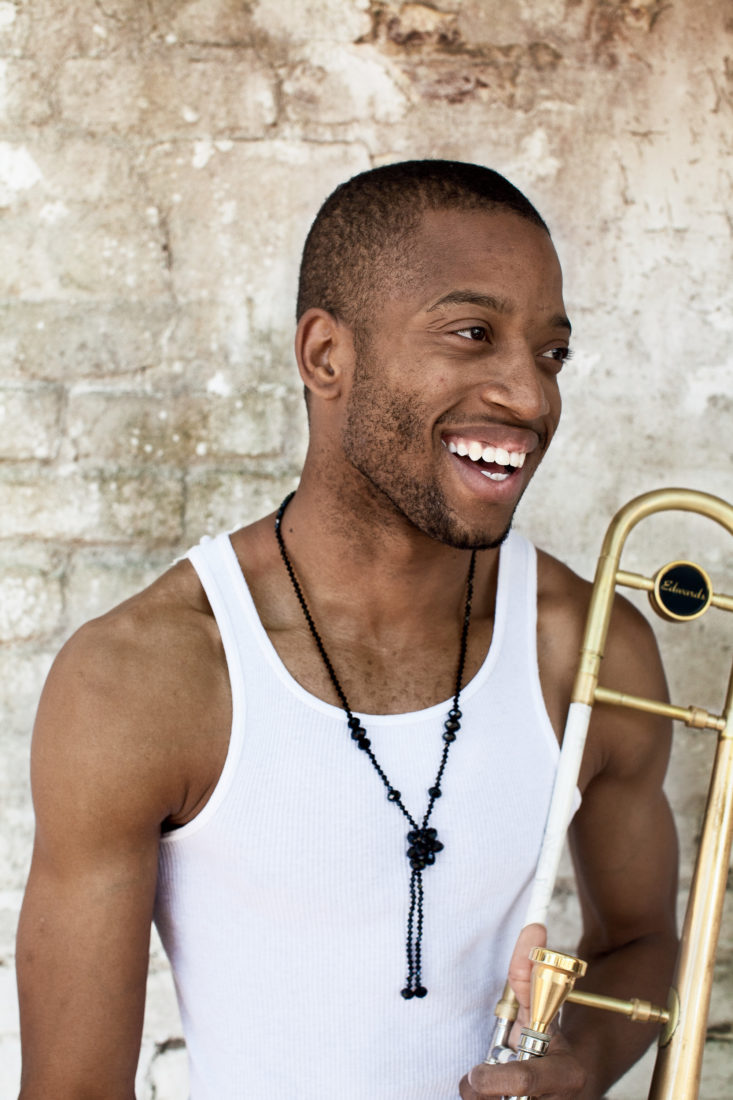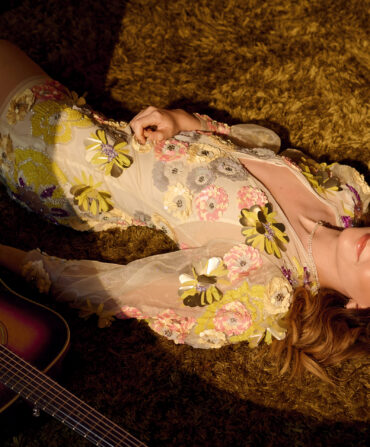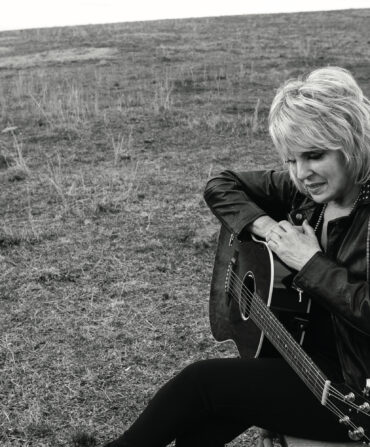Artists
Trombone Shorty: NOLA’s Soul Man
Trombone Shorty isn’t your average jazzman

Photo: Eric Kiel
Troy Andrews looks tired. He has every reason to be—it’s two o’clock in the morning, people are still pouring into Tipitina’s in Uptown New Orleans for his show, and he already played an hour-long set today in the pounding Louisiana sun at Jazz Fest. Folks are milling around the dressing room, but he’s quiet, sitting in the corner, straddling the arm of a beat-up leather couch and tapping out a silent solo on his tarnished vintage trumpet.
Andrews, better known as Trombone Shorty, isn’t the regular sort of New Orleans jazzman. Twenty-five years old, he’s lanky and muscular, with a thin shaved head and cheeks that swell up to the size of softballs. He’s wearing dark jeans, a gray Express polo with a red lion on the front, and around his neck a string of black beads his nephew gave him. His voice is untouched by rasp.
The dressing room looks like a family reunion—his brother Buster is here, with his father, his godmother, cousins and friends. Andrews has been on the road for a few months now, playing everywhere from Japan and Chile to Georgia and California, and so visits back home are few, brief, and dominated by studio time as he works on a new album.
Outside on Napoleon Avenue, there’s been a line building since one o’clock in the morning. Many of the people in line saw the Jazz Fest show—but all of them know that a Trombone Shorty show at Tipitina’s is not to be missed. Tickets sold out weeks ago.

The stage is dark as a hard guitar line starts “Suburbia,” a Nine Inch Nails–inspired track off Backatown, his most recent CD. Drums wind it up, the brass explodes, and the lights come up. Andrews is dressed in his trademark black wifebeater and a pair of wide designer shades, right foot braced against the stage and trombone pointed up like a piece of artillery. He no longer looks tired.
New Orleans may have produced national acts like Galactic and Lil’ Wayne in recent years, but the music that defines the city hasn’t reached a wider audience for a long time. To most people, it’s a Zatarain’s commercial-squealy trumpets, a pooting tuba, and a Louis Armstrong impersonator. Trombone Shorty is something different. A young scion of a long-standing musical dynasty, he plays a furious hard-rock-and-funk-tinged brand of New Orleans brass twisted into something wholly new. In the years since Hurricane Katrina, he’s become the voice of a city determined to prove itself more than a touristy backwater good for beer, beads, boobs, and nostalgia for the twenties and thirties.
Andrews grew up in a green house with a brick facade and orange hurricane shutters in Tremé, the New Orleans neighborhood that produced icons like Tuba Fats and Kermit Ruffins (as well as countless brass marchers in bands now fanned across the city). “As a kid, I would wake up and there’d be a jazz funeral while I’m walking to school,” Andrews says. “And when I come home you can find Rebirth band playing for a birthday party the same day.”
When he returns home now, he’s the hometown boy made good. He cuts that image well, with his black Camaro, dark glasses, and perpetually ringing iPhone. People rush to say hi, and he knows everybody—a good number are actually his cousins. He pays his homage at the Treme Brass Band’s weekly show at the Candlelight Lounge on North Robertson. He keeps a pocket full of tens and twenties to hand out.

Photo: Eric Kiel
Troy Andrews, aka Tombone Shorty, in New Orleans on May 7, 2011.
Everyone says they knew he’d be big. In the Tremé, brass was like baseball: Not every kid was going to make it his life, but nearly every one of them played. Andrews started early. The second-youngest of six kids, he’d crawl around and mess with the instruments that littered the house when he was so small he could fit in a tuba bell. His brother Buster remembers that Wynton Marsalis showed him a few lines when he was in a stroller blowing on a plastic saxophone.
The Andrews family was royalty in that world. Troy’s grandfather Jessie Hill wrote “Oo Poo Pah Doo,” a classic Mardi Gras Indian and brass-band song. His cousin Glen David Andrews is another bandleader in the city. More cousins play in the Rebirth Brass Band, the Dirty Dozen Brass Band, and the Hot 8.
His brother James is a famous musician in his own right. James is every bit the jazzman Troy isn’t—rounder than his rail-thin kid brother, he’s talkative and bubbly where Troy is reserved and businesslike. His raspy voice and singing trumpet earned him the nickname Satchmo of the Ghetto. Sixteen years older than Troy, James served as a father figure, musically and otherwise. “Before he could walk, I had him on my back in the French Quarter, I brought him to hear everybody,” James says. “Earth, Wind and Fire, Luther Vandross, everything that I wanted to go to, but I had to watch him because my mom was going out with my dad that night—to the same show, come to find out.”
When Troy learned to play, James put him in a little suit and brought him on tour. He took him all over the world: Dubai, Paris, Turkey, Cuba. He was learning that easy, New Orleans music that made his brother famous, but also the kind of tireless professionalism that allows him today to play two consecutive sets before going back to the studio to record the next morning
He was a bandleader by age six. In between international travel, he started his first real band, the Tiny Tunes, who would march around the French Quarter for tips—Andrews could play anything, and there was nobody playing trombone, so he settled in with the less popular instrument.
When he first started playing, the trombone was twice his height. Hence “Trombone Shorty.”
They may have been filled with music, but the streets of the Tremé were dangerous. When Andrews was ten, his older brother Darnell, D-Boy, was shot and killed in the nearby Lafitte housing projects. He played trombone, too, “better than Troy, if you ask me,” Buster says.
“I guess I kind of took his spot,” Andrews says.

Photo: Eric Kiel
Andrews and his Edwards trombone.
They were hard years for the Andrews family, and for the city. New Orleans had been on a slow decline since the mid-sixties.
Corruption and inertia came to stand in for the vitality and creativity that had defined the star of the South throughout the nineteenth and early twentieth centuries. Bands like Rebirth and Bonerama were taking traditional marches and mixing them with funk, but few people outside the city knew about them. Someone like Wynton Marsalis had to go to New York for national recognition.
After Darnell’s death, Susan Scott, a local woman who was managing James at the time, took Andrews in. A businesswoman and a member of an old Atlanta family, she had a sterling reputation in the city. Andrews still wonders what his life would have been like without her—he calls her his second mom, and his guardian angel. She died of cancer in 2007. “I have a bunch of cousins, and friends, and people who grew up with me who didn’t have the same opportunity,” Andrews says. “I’ve lost a bunch of friends—some of them in jail, some of them made bad choices, some of them aren’t where they should be. If I didn’t have her, I could see myself being where they are now.”
She arranged for him to audition at the New Orleans Center for the Creative Arts, where he played with his future drummer and bassist. He learned standard notation and acquired a theoretical discipline that set him apart from some of his more freewheeling colleagues. When he started putting his current act together, he’d make his band practice in the dark so that nobody could rely on watching their bandmates.
In 2004, Lenny Kravitz was looking to fill out his horn section with some Big Easy brass. He called his friend Sidney Torres, a New Orleans garbageman/hotelier/actor. Torres knew whom to call.
Kravitz asked him: “Does he have any soul?”
“Yeah, he’s got lots of soul,” Torres said.
Kravitz asked Torres how old he was. He was incredulous: “How could an eighteen-year-old have soul?”
When Kravitz heard him play for the first time, he literally fell to his knees.
When Katrina hit, in 2005, nineteen-year-old Andrews was on an international tour with Kravitz. At that point, no one knew whether the city of New Orleans would survive. Musicians lost their homes, their instruments, and their patrons, and the city’s long obsession with preserving its culture became a desperate struggle.
Andrews came back eight months later and played a show at the House of Blues to a city still just holding on. He had developed considerably. His time with Kravitz had given him discipline and rock-star performance chops, and it became clear that his sound was evolving as well. What he was doing was different than preservation or recovery—it was new.
Eventually, the city started doing something similar. It might have been stagnating beforehand, but now it routinely appears on lists of hot cities for start-ups and investment. It’s become ground zero for educational reform. A local joke once said that New Orleans had a thousand restaurants but only one menu; now dozens of restaurants new and old are realizing that the standards don’t cut it anymore. “Everything was wiped out,” Andrews says. “Everyone had to struggle to get back to a steady pace. But it’s changing in a way where we don’t want it to be the same New Orleans that it was—we want to be better in every aspect. Business, music, restaurants, whatever it may be.”
His profile has only grown since—stars from Allen Toussaint to the Edge have sung his praises, and he’s played with U2, Green Day, and the Dave Matthews Band. He and his band, Orleans Avenue, have played to audiences as big as twenty thousand in places as far away as Australia. His 2010 album, Backatown, topped the Billboard jazz chart and got nominated for a Grammy.
For people who have listened to New Orleans music for decades, it’s an exciting time. “I witnessed the Neville Brothers in 1984, and all the promise and energy and talent that had been sitting in that one family finally came together and were distilled into one act,” says New York University music professor Ashley Kahn. “And I remember when Miles created something that was totally his own. I think Trombone Shorty is cut from that same cloth.”
He’s not your typical jazzman, but he’s not your typical rock star either. He doesn’t do drugs, doesn’t drink, and doesn’t do much of anything that isn’t music. He says the craziest thing he’s done is to get a tattoo of a panther on his left shoulder when he was eighteen. He’s going to get it removed when he has time.
When Andrews says they’re going to party “till the sun comes up,” he means it.
“Is anyone out there tired yet?” he asks, an hour into his Tipitina’s set at around four in the morning. “This is how we do it in New Orleans every night.”
He is the consummate bandleader—ordering drum strikes with his body, pulling high notes out of his saxophone players, and bounding across the stage with a tense, spiderlike energy. He fills an idle moment with a pelvic thrust.
He may have taken this act across the world, but this is his home turf. At five a.m. the crowd is still sweating shoulder to shoulder all the way to the back of the club. This show is a long way from the playful jazz that the country knows as classic Crescent City. But it feels more New Orleans for all of that—there was a time when that old sound was new, too.
Tomorrow he would be back in the studio working on the next album. Next week he’d be in L.A., the week after that in Virginia, then Georgia, Alabama, Colorado, and California again. He heads to Europe this summer. He played every night in the city when he was still a teenager. “It’s nothing new,” he says. “It’s just that everybody else is watching now.”
New Orleans is not fixed. Urban blight, crime, poverty, and the continuing devastation from the storm remind natives and visitors alike that the city remains a frontier—and the promises of a still-developing economic future are far from certain. But it’s hard not to feel that a city that produces a Trombone Shorty stands a chance.
“As of right now, one thing I need is a little sleep once in a while,” Andrews says. “Bring it on.”







